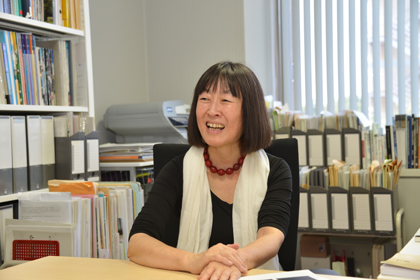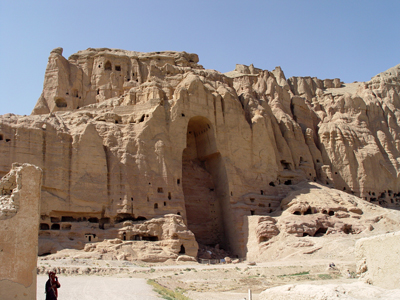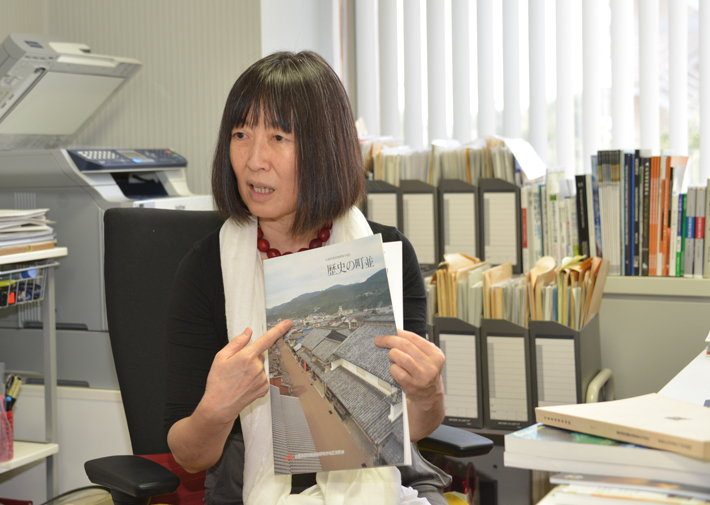TSUKUBA FRONTIER
#07 Contributing to the Attainment of a Sustainable Society through World Heritage
World heritage sites have come to be recognized as a "brand" denoting the most preeminent sightseeing destinations, but their original significance is as a means of international cooperation to protect the world's cultural and natural resources from war and development. As an international expert, Prof. Inaba is involved in applications for and examination of world heritage status, and engages in examination of universal values to be protected and possible approaches to sustainable development.
Professor INABA Nobuko, Faculty of Art and Design

■ Protection of cultural and natural assets and the World Heritage Convention
The United Nations Educational, Scientific and Cultural Organization (UNESCO) was founded in 1946. The UNESCO Constitution on which it is based stipulates, as one purpose of the founding of the organization, "assuring the conservation and protection of the world's inheritance...and recommending to the nations concerned the necessary international conventions." In 1972, this was further elucidated in the form of a "Convention Concerning the Protection of the World Cultural and Natural Heritage (World Heritage Convention)." This took quite some time.
 Many precious cultural assets were lost in the course of two world wars and the subsequent recovery processes. The protection of cultural assets is related to peacekeeping processes, and is an important role of UNESCO, but questions such as how to obtain funding and who is to do what, were not easily answered. Building on the experience of protecting the Nubian remains in Egypt from development through an international campaign in the 1960s, work was undertaken to prepare what is the current World Heritage Convention, recognizing that a permanent framework for international cooperation was after all necessary. Protection of cultural assets is first of all a problem for the nation in question, and therefore requesting protection by another nation would constitute infringement of national sovereignty. However, if the cultural property in question that has been registered as a result of application by the corresponding national government on the basis of an international convention, then a reason is established for assistance by other nations in protecting the property. The original purpose of the World Heritage Convention is to draw on international cooperation to protect cultural properties that are exposed to dangers in countries where systems or funding are inadequate.
Many precious cultural assets were lost in the course of two world wars and the subsequent recovery processes. The protection of cultural assets is related to peacekeeping processes, and is an important role of UNESCO, but questions such as how to obtain funding and who is to do what, were not easily answered. Building on the experience of protecting the Nubian remains in Egypt from development through an international campaign in the 1960s, work was undertaken to prepare what is the current World Heritage Convention, recognizing that a permanent framework for international cooperation was after all necessary. Protection of cultural assets is first of all a problem for the nation in question, and therefore requesting protection by another nation would constitute infringement of national sovereignty. However, if the cultural property in question that has been registered as a result of application by the corresponding national government on the basis of an international convention, then a reason is established for assistance by other nations in protecting the property. The original purpose of the World Heritage Convention is to draw on international cooperation to protect cultural properties that are exposed to dangers in countries where systems or funding are inadequate.
■ The role of the World Heritage Convention as a tool for policy

The definition of world heritage is "heritage of outstanding universal value that should be protected by the people of the world collectively." This is not limited to what is beautiful, what is precious, or what can be appreciated. Initially, only famous ruins and structures were registered, but from the 1990s an overemphasis on Europe and America was remedied, and there was a shift to focus on the diversity of the world's culture and nature, with increasing emphasis on the cultures of minorities around the world.
This is in keeping with an international trend toward asset protection. As the scope of cultural asset protection expands, in addition to preservation efforts to strictly maintain cultural assets in their original state, there is an increasing understanding that cultural and natural assets that contribute to "sustainable development"--that is, preserving neighborhoods and scenery without inhibiting the activities of people or regional development--are also important. The former is the responsibility of experts, but for the latter, town planning that involves the local residents is essential.
Applications for registration as world heritage sites can be submitted only by national governments, not by regional or local governments. Applying for world heritage status means that the nation makes an international commitment to creating a long-term development strategy that balances preservation of cultural and natural resources with regional development that takes into account a stream of tourists.
■ The role of international experts
World heritage sites have acquired the status of a kind of "brand." This is proof that the system has matured, but there remain many, many problems relating to the functions of protecting cultural and natural assets. From the start there has been the concern that the principles of the Convention would be forgotten and the list of world heritage sites would become merely a sightseeing guide. Moreover, numerous valuable areas, including world heritage sites, continue to be destroyed as a consequence of unbridled competitive development accompanying the emergence of a developing nation or the occurrence of armed conflict in various corners of the world.
UNESCO and international experts are reviewing the future direction of the World Heritage Convention by examining the need for protection of world cultural properties, drawing on international relations and the global economy, and at the same time turning back to the original objectives of sustainable development and the protection of endangered cultural properties.
■ The key to sustainable development is the "mastermind"
When discussing protection of cultural assets, the restoration of works of art or other products of artisans probably comes to mind, but there is a serious need for persons capable of coordinating international cooperation and regional revitalization. For example, when an attempt is made to assist in protecting a historical site, in addition to archaeological excavation, a wide range of other comprehensive activities are expected, from evaluation of the cultural value of the site to the preservation or restoration of buildings, preparation of infrastructure in the surrounding region, and the development of a tourism framework. Experts in all these fields must be assembled, and coordination with the local citizens also involved, or else appropriate cultural property protection and sustainable development will not be possible. The person who is key to the realization of all this is the coordinator--the "mastermind."
The qualifications of the "mastermind" do not simply constitute familiarity with the site. In addition to the basics of such fields as architecture, civil engineering, chemistry, biology, environmental science, archeology, and art production, they must also have knowledge of the preservation of cultural properties and natural resources, public policy, and international cooperation. A truly interdisciplinary background is required.
Regardless of the scale involved, the principles of the World Heritage Convention serve as a model for urban development and activities to protect cultural properties the world over. While cultivating expert personnel for roles as "masterminds," Prof. Inaba herself is a leader in pursuing the ideal form of sustainable development.

Article by Science Communicator at the Office of Public Relations


